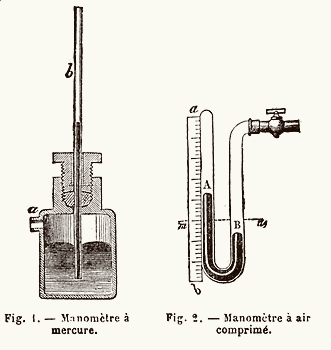Manometer

MANOMETER substantive (gr. manos, rare; metron measure.) Physics. Instrument used to measure the stress of gas or vapor: the manometer of a steam engine.
— The force of fluids contained in a closed space is usually expressed in units of atmospheric pressure, called atmosphere, which are equal to a column of mercury 76 centimetre (29.9213 inches) high. Various forms of manometers can be classified into 3 categories, based on various principles: 1° open manometer, 2° compressed air manometer, 3 ° metal manometer. Our figure 1 shows an open manometer, composed of a bottle containing mercury, in which a vertical tube b is immersed. A second tube a, which is connected to the gas or compressed steam, is also secured to the bottle. This device may come in various shapes. The compressed air manometer (Fig. 2) is built according to the principle of the law of Boyle. The main component of the metal manometer is a spiral-shaped copper tube, closed at one end, while the other end is left open, and can be connected to the tank containing the fluid whose stress we want to measure.
Extract from the Trousset encyclopedia, 1886 – 1891.
Tags: instrument, physics, science and technology, Trousset encyclopedia


